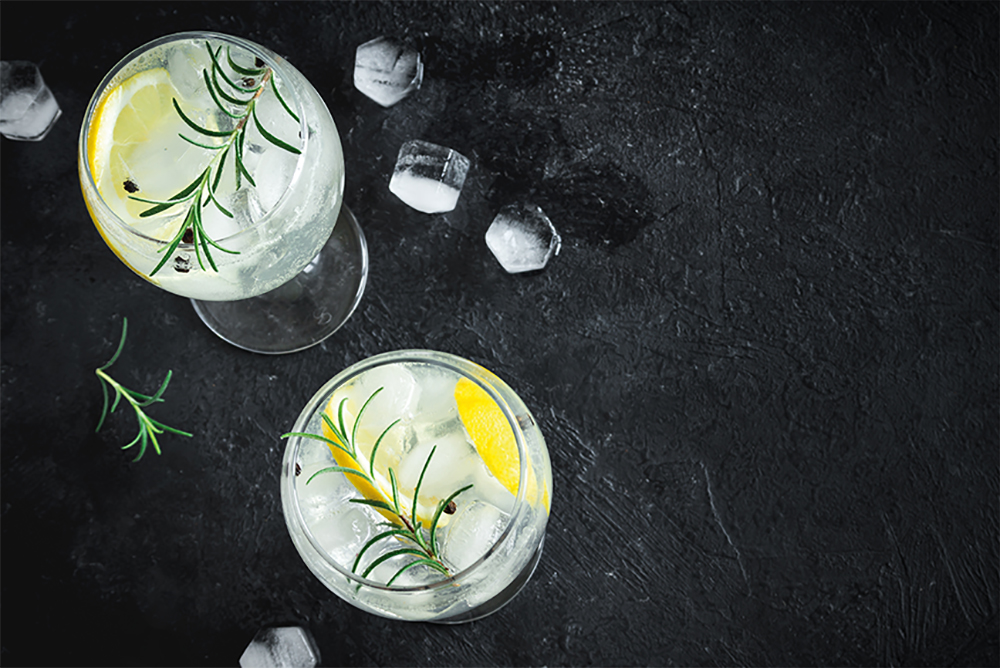Distilling the history of our fascination with gin, from mother’s ruin to a recent wave of local gins, Dr Sue Bailey celebrates Ginuary
Following the excesses of Christmas, do you yearn for a light, aromatic gin to celebrate Ginuary? When I spoke to my half-Dutch partner about gin, he reminded me that in the late 18th century, when people drank gin, they were usually drinking a version of Dutch-style genever: a dark, potent spirit not at all like the gin that we drink today.
Genever typically has a base of malt wine, which is a distillation of rye, corn and wheat, and is much more like a light Scotch. We are lucky enough to have some examples of these early bottles in the preserved bar at the Museum of Cambridge. By way of contrast, gin as we know it comes from mixing a neutral spirit base with a blend of botanicals, predominantly juniper.
But when did the liking for gin develop? Dutch and English soldiers consumed genever in the 16th century, giving them ‘Dutch courage’ for fighting the Spanish. By the time the Dutch king William of Orange sat on the throne in 1689 and boycotted French brandy imports, genever had become very fashionable. A year later, distilling in England was liberalised and there was a rapid growth in small distilleries.
Unfortunately, those artisanal distilleries were not sophisticated, unlike the creators of the flavoursome gins we enjoy today. Georgian distillers used poor quality, raw grain-based ingredients and lacked expertise, shortening the name of genever to gin. It became incredibly popular, being cheaper to drink than beer (but much stronger!), supposedly safer than contaminated city water and prevented the poor from feeling cold and hungry. Because of these factors, many drank more than two pints a week, often with fatal consequences.
Taxing and licensing failed to control this crudely made gin, sometimes flavoured with turpentine and contaminated with sulphuric acid. But the next Gin Act forced distillers to sell only to licensed retailers trading from respectable premises. This controlled the horrors portrayed in Hogarth’s ‘Gin Lane’. Then, failing grain harvests increased the price beyond the reach of the poor, who turned back to beer.
There is a real preference for local small producers
Local author and historian Caroline Biggs tells me about a Cambridge newspaper of 1796, which gave the following “Friendly Advice to the industrious poor – gin is poison; he that drinks it gives him false spirit for a while and rots his liver all the while. If a gin maker be not the greatest enemy to the public, a gin drinker is the greatest enemy to himself and family”.
But it wasn’t just drunken men – Caroline is writing a book about the 19th century moral policing and imprisonment of women by Cambridge University authorities. She says, “Drunken women were feared by the proctors who, during term time, patrolled the streets in search of any women believed to be ‘loose’, for fear them of seducing the students.”
Caroline has found a 19th century gin list from the Anchor pub, and in contrast to the vast number of gins now sold in pubs and bars, only four gins were available. These were: gin cordial – basically a gin-based liqueur; London Dry Gin – named after the clean, fresh tasting spirit typically made in London; Old Tom, which was a sweetened gin; and an unsweetened, plainer gin.
An original 1864 recipe from the Beefeater Distillery for Old Tom gin confirms that it contained juniper berries, coriander seed, angelica root, ground liquorice root and winter savoury. The name comes from the wooden plaque shaped as a black cat (Old Tom) outside pubs often with a nearby slot for payment, where thirsty passers-by could drink a shot of gin poured through a tube.
Fast forward to this century, and why has there been such an interest and resurgence in gin? I spoke to Mark Anstead, who runs gin tasting workshops at the Tamburlaine hotel every month. “Following the trend of the American introduction of craft distilling, just ten years ago Sipsmith managed to get a repeal of the Gin Act of 1751 that prevented small batch distilling. Since the repeal, hundreds of new gins have come on to the market. But it’s not just availability; there is a real preference for local, small producers and we love the idea of locally sourced, foraged botanicals and carefully crafted gins.”
Mark does themed tastings of a wide variety of gins in his workshops and reminds us we are lucky to have locally made gin from Cambridge Distillery and Pinkster, as well as gin from Ely and Newmarket. Josh Vargo, owner of the Green Man, Grantchester, and Karen Paxton, general manager of The Red Lion, Grantchester, tell me that historic Old Tom and gin cordials are having a resurgence and they both stock a wide selection of these.
Emily Robertson, a new gin maker based near Huntingdon, wanted her Roundwood gin and brand to reflect the less well-known, rural side of Cambridgeshire. “We’ve gone with a fairly fruity line-up of botanicals,” she says. “The inclusion of elderberry in the blend really lifts the dry juniper. My favourite thing about distilling is the overlap between science and creativity.”
Pinkster gin owner Steven Marsh, based in Newton, follows the berry theme with raspberry-based pink gin and Hedgepig Fruit Gin liqueurs, and cleverly makes boozy berries from the recycled raspberries. He also makes gin jam; it’s not alcoholic, so even if you’re doing dry January, you can pop it on your toast and still get your gin fix!

